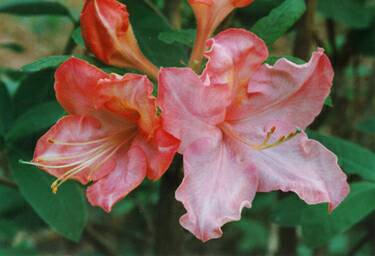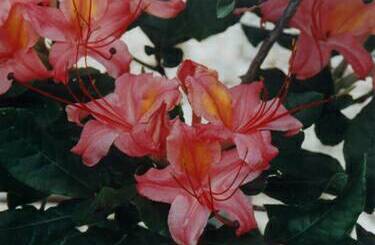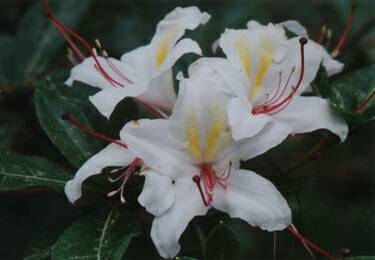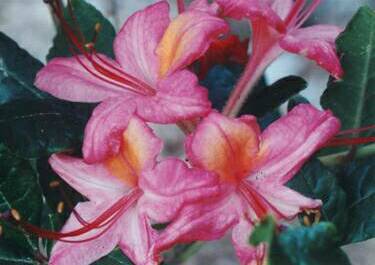Joe Parks, Dover, NH
Even with highly competent hybridizers such as we have in New England, it is not often that a group of plants is developed that solves a particular problem. But that is what has been done in the case of the new Cherokee Series deciduous azaleas. I have bred these azaleas specifically for performance in humid, challenging climates such as the Northeast. They will of course also do well in other climates.

It is well known that, although spectacular in bloom, hybrid deciduous azaleas seldom add much to the landscape. In fact it is not unusual for them to be rather pitiful looking for much of the growing season. Insects eat flowers and leaves in the spring and in summer the leaves often become disfigured by mildew. But now, with the new Cherokee Series, we have a remedy.
These insect and disease resistant, dark green, hardy hybrids are clearly the wave of the future. In the first place, few gardeners have time for special plant care. And second, the availability of insecticides and fungicides for home use is probably on a long-term decline. Thus plants such as these that do not require special care and are minimally affected by insects and disease are becoming increasingly popular.
Specifically, the Cherokee Series azaleas have been bred to resist Mildew and Green Sawfly larvae ("little green worms"). These are both common in the Northeast. Green Sawfly larvae attack and decimate the leaves of established plantings just at flowering time. If the infestation is severe, they may destroy flowers also. Mildew, a common fungus disease of deciduous azaleas in humid climates, typically disfigures - and sometimes kills - the leaves after the flowering period is over.
Insect resistance of rhododendrons has been found to result from the presence of naturally occurring chemicals (terpenes) in the leaves.1 Thus the high level of these chemicals in the Cherokee Series may also reduce or prevent damage by other insects such as the Azalea Caterpillar. However, field tests have not been conducted to determine this. Note that Green Sawfly larvae do attack and eat small bits of leaves on resistant plants. However, they stop eating before significant damage occurs to a leaf. Then they disappear. Therefore there is no need for fungicides or insecticides.
So far nine cultivars have been registered in the Series with testing continuing on a number of others. These new cultivars provide a long flowering season. In New Hampshire it extends from early June to late July. Colors range from solid whites and pinks to mixtures of various colors; reds, yellows, pinks and oranges. On some of the plants the colors vary from flower to flower and truss to truss. It should also be mentioned that all are fragrant and some intensely so.
The plants have also been selected for their appearance in the landscape when not in flower. All but one have dark green leaves. In addition, the leaves of some are quite glossy and others rugose giving a solid, heavy appearance like an evergreen. Thus these are plants that add to the landscape throughout the summer. After a decade or more in the nursery their heights range from about 30 inches (75 cm) for 'Cherokee Coral Beauty' to over 6 feet (2 m) for 'Cherokee Big Peach'. Most prefer the sun but some also do well in shade.
The following descriptions and images provide more detail on each cultivar.
Descriptions of the Cherokee Series Azaleas

'Cherokee Big Peach' ([Exbury seedling x atlanticum] x ['Chelsea Reach' x viscosum]) is a vigorous, heavy grower. It has large thick leaves, heavy stems and flowers that would grace an elepidote rhododendron. The moderately fragrant 2.5 inches flowers change from peach to pink as they become older. They are at their peak the first week of June in New Hampshire. It does best in the sun.
'Cherokee Coral Beauty' (viscosum ssp. glaucum x cumberlandense) is a relatively slow growing, bushy plant. Its dark green rugose leaves make it a nice plant in the landscape. The spicy fragrant flowers are at their peak towards the end of the first week in July. It does well in the sun or half shade.

'Cherokee Frosty Morn' (arborescens x ['Chelsea Reach' x ??]) is a nice bushy plant, with glossy, dark green leaves. The white flowers, with a deliciously sweet fragrance, appear in the second week of June. It does well in sun or half shade.

'Cherokee Lemon Chiffon' (arborescens x 'Vineland Flare') has never been out of the nursery so its ultimate shape is unknown. Even its current 4 foot height may be suspect but its glossy green leaves certainly are not. The mix of lemon yellow and white in its lovely, moderately fragrant flowers varies from flower to flower. However the upper petals tend to be lemon and the lower to be white. It is somewhat leggy in half shade so probably will do best in the sun.
'Cherokee Maid' (not registered, name subject to change, no image) is a low growing plant (under 2 feet) with glossy green leaves and pink flowers that is expected to be registered in 2000. It has maintained its low stature in three-quarter shade.

'Cherokee Rose Beauty' (viscosum ssp. glaucum x cumberlandense) was originally named 'Cherokee Rose' but this was not allowed under the nomenclature system. The moderately fragrant, rose pink flowers appear the first week of July. Leaves are a dark, glossy green. Currently about 3.5 feet high, once it reaches maturity out of the nursery this should be a beautiful bush. It prefers full sun.

'Cherokee Star' ('Popsicle' x 'Vineland #6038') is a fairly tall (5 feet) plant with dark green leaves. The pink, starry flowers are moderately fragrant and appear the second week of July. It has proven to have an exceptionally long flowering period for me with the flowers often lasting till the end of July. It is somewhat leggy in half shade so would probably do best in full sun.

'Cherokee Sunrise' (flammeum x 'Vineland Orange') is a bushy plant with dark green leaves. It is as broad as it is tall (5 feet). The moderately fragrant pink flowers have a bright orange flare in the upper petal. The trusses tend to be a tight, ball shape so make the plant quite lovely in bloom. Flowers appear towards the second week of June. It does well in light shade, has not been grown in full sun.

'Cherokee Sunset' (cumberlandense x ['Homebush' x 'Vineland Orange']), at 3.5 feet, is a medium growing plant with dark green leaves. The highly fragrant flowers tend to vary in color from flower to flower and truss to truss. Some are pink, some are orange while others are a mixture, but from a distance the overall appearance is a warm sunset color. The flowers appear during the second week of June. It is doing well in light shade and has not been tested in full sun.
'Cherokee Tears' ('Popsicle' x 'Vineland 6038A', no image) at six feet may be abnormally tall because of its life in the nursery. However with its dark, glossy green leaves it is a very nice plant. Its white flowers, tinged with just a touch of pink, have a delightful strong fragrance. Peak flowering is the last week of July although there is scattered flowering much earlier. Currently growing in half shade but appears leggy, would probably do well and be more compact in full sun.